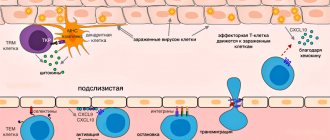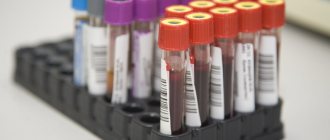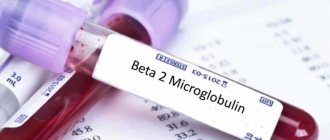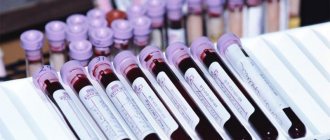Detailed description of the study
The study is important to study the distribution, volume and type of fats. Very low and low density lipoproteins (LP) belong to the atherogenic fraction, and high density lipoproteins help prevent atherosclerotic changes in blood vessels.
Atherogenicity index – the ratio of low- and high-density drugs. This indicator determines the risk of developing atherosclerosis and coronary heart disease. Triglycerides are lipids that are significant for the diagnosis of lipid metabolism disorders - hyperlipidemias, which are divided into five types and differ in origin, pathogenesis and therapy used.
Determining the level of various cholesterol fractions plays an important role in diagnosing cardiovascular pathologies, determining patient management tactics, predicting the development of complications, and monitoring treatment.
Lipidogram
Interpretation of the results of the Lipidogram study
Interpretation of test results is for informational purposes only, is not a diagnosis and does not replace medical advice.
Reference values may differ from those indicated depending on the equipment used, the actual values will be indicated on the results form. Currently, the prognostic significance of the concentration of total cholesterol in the blood is undoubted in relation to the risk of mortality from major diseases associated with atherosclerosis (coronary artery disease and cerebral strokes). When the cholesterol level in the blood is below 5.2 mmol/l, the risk of developing atherosclerosis is the lowest. If the concentration of LDL cholesterol in the blood is below 2.59 mmol/l, atherosclerotic changes in the coronary arteries rarely occur.
An increase in LDL cholesterol above 2.59 mmol/l is observed when eating foods rich in animal fats and cholesterol. Physical inactivity, unbalanced nutrition, resulting excess body weight, smoking, arterial hypertension, diabetes mellitus are factors that increase the risk of coronary artery disease. The presence of at least two of the above factors accelerates the development of critical coronary atherosclerosis by approximately 10 years.
Reducing the concentration of total cholesterol in the blood and increasing HDL cholesterol reduces the progression of atherosclerosis. A 10% reduction in total cholesterol levels in the blood leads to a 20% reduction in mortality from heart disease. An increase in HDL cholesterol concentration by 0.03 mmol/l reduces the risk of coronary disease by 2-3% in men and women. In addition, regardless of the content of total cholesterol in the blood (including those exceeding 5.2 mmol/l), an inverse relationship remains between the content of HDL cholesterol and the incidence of cardiac pathology.
Concentrations of HDL cholesterol less than 1.3 mmol/l and triglycerides in the blood more than 2.3 mmol/l are independent prognostic indicators of the likelihood of death from coronary artery disease. Therefore, HDL cholesterol levels should be considered a more accurate predictor of mortality from coronary artery disease than total cholesterol concentrations.
Based on the above, the following aspects should be taken into account in clinical practice:
- Reducing the concentration of LDL cholesterol and increasing the concentration of HDL cholesterol helps reduce the risk of developing atherosclerosis.
- The level of testosterone in men and estrogen in women is directly related to lipid metabolism disorders.
- The concentration of Lp(a) in the blood serum reflects the activity of the atherosclerotic process.
- Low physical activity (physical inactivity), excess nutrition, and smoking have an adverse effect on lipid metabolism.
- Correction of lipid disorders should be aimed not only at reducing blood cholesterol levels, but also at normalizing the lipid profile.
- Exercise and weight loss reduce plasma LDL-cholesterol and triglyceride concentrations and increase plasma HDL-cholesterol concentrations.
- A healthy lifestyle will prevent the development of atherosclerosis, the foundations of which can form at a relatively young age.
Optimal lipid profile (lipid profile):
- Total cholesterol
- HDL cholesterol > 1.3 mmol/l.
- LDL cholesterol
- Triglycerides
- CA
- AIP
A study of lipid metabolism (lipidogram) should be carried out in individuals in the age range from 20 to 80, every 5 years. It must be remembered that the likelihood of developing IHD and cardiovascular diseases increases if the subjects have other risk factors (smoking, diabetes mellitus, arterial hypertension, family history of IHD in first-degree relatives that developed in men under the age of 55 years, in women under 65 years of age). Therefore, to successfully reduce mortality from cardiovascular diseases, this population must be tested for the presence of all these factors.
References
- ESC/EOA Clinical Guidelines for the Diagnosis and Treatment of Dyslipidaemias, 2021.
- Russian recommendations VI revision. Diagnosis and correction of lipid metabolism disorders for the prevention and treatment of atherosclerosis, 2021.
- NCEP Expert Panel on detection, evaluation and treatment of high blood cholesterol in adults. Executive summary of the third report of the National Cholesterol Education Program (NCEP) Expert Panel on detection, evaluation and treatment of high blood cholesterol in adults (Adult Treatment Panel III). JAMA 2001;285:2486–2497.
Lipidogram (total cholesterol, triglycerides, HDL, LDL, atherogenic index)
[P 3.2.4]
| Price | Add 480 rub. |
| Ready time | 3 hours from the moment the biomaterial arrives at the laboratory |
| Material for research | Blood |
| Special conditions | Strictly on an empty stomach! |
| analysis included in the following profiles |
|
High-density lipoproteins (HDL) - belong to the group of “good” lipids and reduce the risk of developing atherosclerosis and cardiovascular disease. They remove cholesterol deposits from the walls of blood vessels, delivering them back to the liver for processing or excretion. Serves our body: to produce bile acid, which is necessary for the absorption of fats in the small intestine; it is the “raw material” of steroid hormones of the adrenal cortex (hydrocortisone and aldesterone), as well as female and male sex hormones (estrogens and androgens); for the formation of vitamin D, necessary for bone tissue, the nervous system, insulin production, maintaining muscle tone, mineral metabolism, immunity; for the normal activity of serotonin receptors in the brain. Serotonin is a substance responsible for a good mood. Low cholesterol levels cause depression and aggressive behavior.
Low-density lipoproteins (LDL) - belong to the group of “bad” lipids and increase the risk of developing atherosclerosis and cardiovascular disease. Low-density lipoproteins (LDL) - carry cholesterol to build the walls of blood vessels. But its excess tends to settle in them. Cholesterol plaques, growing, worsen the patency of blood vessels. And this reduces blood supply - nutrition of tissue organs. This disease is vascular atherosclerosis. The insidiousness of this disease lies in the fact that its symptoms - disturbances in the normal functioning of organs - appear only when the lumen of the vessel is closed by 75%. Hence such diseases of the circulatory system as: coronary heart disease, which can lead to myocardial infarction; thrombosis of arteries and veins; brain stroke; gangrene of the lower extremities.
Cholesterol is synthesized in the liver and is found in almost all cells of the body. Cholesterol enters the body from two sources: 70% of it is produced by the liver, and 30% comes from food.
Back to section
Interpretation of lipid profile results
Interpretation of the results is based on comparison of the obtained indicators with the norm. They are usually indicated on the analysis form. Normal values for adults are:
- total cholesterol - 0–5.2 mmol/l;
- VLDL - 0.13–1.63 mmol/l;
- LDL - 0–3.3 mmol/l;
- HDL - 1.03–1.55 mmol/l;
- triglycerides - 0–2.25 mmol/l.
Elevated levels of VLDL, LDL and triglycerides are associated with high risks of atherosclerosis and cardiovascular disease. Risk assessment (medium, increased) is carried out taking into account the patient’s age, gender, blood pressure and whether he smokes or not.
It’s easy to get a lipid profile at the Spectra clinic - just sign up for the test and come on the chosen day. The treatment room operates on a schedule convenient for patients and without queues. Analysis results are ready within 2–3 days.
Lipid metabolism analysis
A blood test for cholesterol and its fractions is called a lipidogram (lipid profile). This analysis is mandatory for every person - it helps to assess the risks of developing cardiovascular diseases.
A typical lipid profile looks for the following levels:
total cholesterol (TC); high density lipoprotein cholesterol (HDL); low-density lipoprotein cholesterol (LDL); triglycerides (TG).
The patient may be assigned a detailed lipid profile. This is done in this case if one or more people in a person’s family suffer from hypercholesterolemia.
There are certain limits for lipid profile indicators for healthy people who do not suffer from cardiovascular pathologies. They are:
TC – less than 5 mmol/l (<200 mg/dl); LDL – less than 3 mmol/l (<115 mg/dl); HDL – in men above 1 mmol/l (>40 mg/dl), in women above 1.2 mmol/l (>45 mg/dl); TG – below 1.7 mmol/l (<150 mg/dl)
For those patients who suffer from angina, diabetes or atherosclerosis, have had a stroke, heart attack or serious surgical interventions in the cardiovascular system, normal cholesterol levels will be completely different.
Reference values (Deciphering lipid metabolism analysis)
| Index | Normal values | ||
| Total cholesterol (TC) | Age < 5 years 5–10 years 10–15 years 15–18 years | Men 2.95–5.25 3.13–5.25 3.08–5.23 2.93–5.10 | Women 2.90–5.18 2.26–5.30 3.21–5.20 3.08–5.18 |
| Triglycerides (TG) | Age < 10 years 10–15 years 15–18 years | Men 0.34–1.13 0.36–1.41 0.45–1.81 | Women 0.40–1.24 0.42–1.48 0.40–1.53 |
| High-density lipoproteins (HDL, HDL-C) | Age 5–10 years 10–15 years 15–18 years | Men 0.98–1.94 0.96–1.91 0.78–1.63 | Women 0.93–1.89 0.96–1.81 0.91–1.91 |
| Low-density lipoproteins (LDL, LDL-C) |
| ||
| Age 5–10 years 10–15 years 15–18 years | Men 1.63–3.34 1.66–3.44 1.61–3.37 | Women 1.76–3.63 1.76–3.52 1.53–3.55 | |
| Very low density lipoproteins (VLDL, VLDL-C) | <0.8 mmol/l | ||
| Non-high-density lipoprotein (non-HDL) cholesterol | desired level < 3.8 mmol/l | ||
For people over 18 years of age, normal cholesterol levels are less than 5.0 mmol/L. However, this number is arbitrary, since the doctor must take into account other indicators of the lipid spectrum (LDL and triglyceride levels will be important).
Get tests done at East Clinic:
| Lipid metabolism. Genetic predisposition to dyslipidemia and the development of atherosclerosis. Study of polymorphisms in genes: APOE (C112R T>C), APOE (R158C C>T), APOB (R3527Q G>A), APOB (G>A), PCSK9 (T>C), ABCA1 (R219K G>A) , APOC3 (-455 C>T), APOC3 (-482 C>T), APOC3 (G>C), LPL (N318S A>G), LPL (S447X C>G), PON1 (L55M A>T), PON1 (Q192R A>G). |







